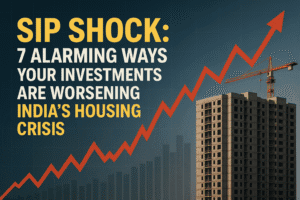SIP Shock: 7 Alarming Ways Your Investments Are Worsening India’s Housing Crisis
India’s crushing home affordability crisis, where even Mumbai’s wealthy face 109 years of saving, may have an unexpected driver: your SIP investments. Surging retail money flooding stocks—via record SIP inflows (₹2.89 lakh crore FY25) and direct buying—created a golden exit for promoters cashing out at peak valuations. The critical question is where this massive wealth landed. Evidence suggests significant portions flowed into premium real estate, setting dramatic new price benchmarks.
Media hype around these luxury sales then “anchored” expectations unrealistically high across all housing segments. This creates a snowball effect: mid-tier sellers hike prices, investment flats sit locked and unsold, while genuine buyers are priced out entirely. The crushing irony? The collective retail enthusiasm fueling stock markets may be unintentionally financing the very housing bubble shutting them out—a hidden link deepening India’s urban divide.

India’s housing dream isn’t just fading for the middle class; it’s slipping through the fingers of even the affluent. Headlines scream the brutal reality: Mumbai’s top 5% face 109 years of savings to buy a home, Gurgaon demands 64, and Delhi and Bengaluru hover around 35 years. While black money, stark inequality, and easy credit are familiar culprits, a less visible force is gaining traction: the tidal wave of money flooding the stock market, particularly through Systematic Investment Plans (SIPs).
The SIP Surge: More Than Just Market Fuel
The numbers are staggering. SIP inflows into Indian mutual funds reached an unprecedented ₹2.89 lakh crore in 2024-25, a massive jump from ₹1.99 lakh crore the year before. Early 2025-26 data shows no slowdown. Crucially, industry estimates suggest nearly 90% of this SIP money finds its way into equity funds, relentlessly pumping capital into the stock market. This is amplified by a retail investing revolution – demat accounts exploded from 3.9 crore pre-pandemic to nearly 20 crore by May 2025, signifying massive direct retail participation.
The Great Cash-Out: Promoters Exit, Retail Buys In
This unprecedented retail demand (both SIP-driven and direct) has created a unique opportunity: a lucrative exit ramp for company promoters and large investors. Evidence is mounting:
- Ownership Shift: NSE data reveals promoter ownership hitting a seven-quarter low by March 2025.
- Retail Dominance: Individual investors now hold a record 18.2% of listed stocks, surpassing foreign institutional investors for the first time since 2006.
- Selling Spree: Promoter sales hit ₹58,000 crore in May 2025 alone, continuing a clear trend.
- IPO Bonanza: The IPO boom, raising ₹1.64 lakh crore in 2024-25, saw a significant portion (₹97,203 crore) come from Offers for Sale (OFS) – essentially existing promoters and investors cashing out to the public.
The Missing Trillion-Dollar Question: Where Did the Money Go?
Promoters selling at perceived high valuations signals a belief that current stock prices may not be sustainable long-term. The critical question is: what happened to the vast sums they pocketed?
The Real Estate Connection: Anchoring a Bubble
This is where the housing bubble hypothesis gains traction. Facing limited high-return alternatives, a significant portion of this cashed-out wealth appears to be flowing into premium real estate. Here’s the insidious mechanism:
- Premium Push: Wealthy individuals, flush with stock sale proceeds, invest in luxury apartments and high-end properties.
- Media Amplification: Sky-high prices for these premium transactions become headline news (e.g., “₹100 Crore Penthouse Sold in South Mumbai”).
- Psychological Anchoring: These reported prices set new benchmarks in the minds of all market participants – sellers, buyers, and brokers. Psychologically, they “anchor” expectations for the entire housing market.
- Trickle-Up Inflation: Owners of mid-range and even modest properties, reading these headlines, start believing their homes are worth significantly more. They hike prices accordingly.
- Investment Glut & Affordability Crash: This creates a surge of “investment” properties hitting the market at inflated prices. However, actual end-users (people needing homes to live in) simply cannot afford these anchored prices. The result? A growing stock of locked, unsold investment flats coexisting with crushing unaffordability for genuine buyers. Brokers, incentivized by builder commissions, often prioritize pushing new launches over these stagnant secondary market properties.
The Human Cost: Locked Doors and Crushed Dreams
The irony is profound. The enthusiastic participation of retail investors in the stock market – through disciplined SIPs and direct bets – is indirectly financing the exits of promoters. The capital from these exits, seeking safe havens or speculative gains, then floods into real estate. This inflates prices, particularly at the top, which then pulls the entire market upwards via anchoring. The ultimate victims are the very people fueling the initial stock surge: ordinary citizens whose dream of owning a home recedes further with every SIP installment and every headline about a record-breaking luxury sale.
Beyond Simplification: A Crucial Piece of the Puzzle
This SIP-to-Real-Estate pipeline isn’t the sole cause of India’s housing crisis. Deep-rooted issues like land scarcity, regulatory hurdles, and genuine demand-supply imbalances in certain segments persist. However, the data on SIP inflows, promoter selling, and retail stock ownership, combined with the psychological mechanism of anchoring, presents a compelling and often overlooked factor. It highlights how capital sloshing through one overheated market (stocks) can rapidly overheat another (real estate), with profound social consequences.
Understanding this hidden link is crucial for policymakers and investors alike, as solutions must address not just bricks and mortar, but the complex flow of capital reshaping India’s urban landscape and the dreams of its inhabitants. The affordability crisis isn’t just about houses; it’s about the unintended consequences of where our collective investments ultimately land.
You must be logged in to post a comment.